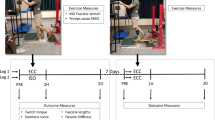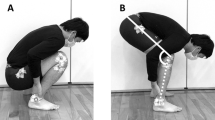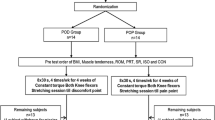Abstract
Purpose
This study compared responses to static stretching between eccentrically damaged and non-damaged muscles.
Methods
Twelve young men performed 60 maximum knee flexor eccentric contractions of one leg, and received a 300-s continuous passive static stretching at tolerable intensity without pain to both knee flexors at 2 and 4 days after the eccentric exercise. Range of motion (ROM) and passive stiffness during knee extension, passive torque at onset of pain (PT), maximum voluntary isometric (MVC-ISO) and isokinetic concentric contraction torque (MVC-CON), and visual analogue scale (VAS) for muscle soreness were measured before, immediately after, 60 min, 2 and 4 days after exercise as well as before, immediately after, 20 and 60 min after the stretching. Changes in these variables after eccentric exercise and stretching were compared between limbs.
Results
The eccentric exercise decreased MVC-ISO, MVC-CON, ROM and PT, and increased passive stiffness and VAS (p < 0.05), suggesting that muscle damage was induced to the knee flexors. ROM and PT increased after stretching for both limbs; however, the magnitude of the increase was greater (p < 0.05) for the damaged than non-damaged limb. Passive stiffness decreased for both limbs similarly (4–7 %) at immediately after stretching (p < 0.05). Significant decreases in MVC-ISO torque (7–11 %) after stretching were observed only for the non-damaged limb (p < 0.05), but MVC-CON torque did not change after stretching for both limbs. VAS decreased for the exercised limb after stretching (p < 0.05).
Conclusions
These results suggest that the static stretching at tolerable intensity without pain produced greater positive effects on damaged than non-damaged muscles.





Similar content being viewed by others
Abbreviations
- ANOVA:
-
Analysis of variance
- CK:
-
Creatine kinase
- CV:
-
Coefficient of variation
- DOMS:
-
Delayed onset muscle soreness
- EMG:
-
Electromyogram
- ICC:
-
Intra-class correlation coefficients
- MVC-CON torque:
-
Maximum voluntary concentric contraction torque
- MVC-ISO torque:
-
Maximum voluntary isometric contraction torque
- PT:
-
Passive torque
- RFD:
-
Rate of force development
- RMS:
-
Root mean square
- ROM:
-
Range of motion
- SD:
-
Standard deviation
- SPT:
-
Static passive torque
- VAS:
-
Visual analogue scale
References
Andersen LL, Aagaard P (2006) Influence of maximal muscle strength and intrinsic muscle contractile properties on contractile rate of force development. Eur J Appl Physiol 96(1):46–52. doi:10.1007/s00421-005-0070-z
Andersen LL, Andersen JL, Zebis MK, Aagaard P (2010) Early and late rate of force development: differential adaptive responses to resistance training? Scand J Med Sci Sports 20(1):e162–e169. doi:10.1111/j.1600-0838.2009.00933.x
Blazevich AJ, Horne S, Cannavan D, Coleman DR, Aagaard P (2008) Effect of contraction mode of slow-speed resistance training on the maximum rate of force development in the human quadriceps. Muscle Nerve 38(3):1133–1146. doi:10.1002/mus.21021
Blazevich AJ, Cannavan D, Waugh CM, Miller SC, Thorlund JB, Aagaard P, Kay AD (2014) Range of motion, neuromechanical, and architectural adaptations to plantar flexor stretch training in humans. J Appl Physiol 117(5):452–462. doi:10.1152/japplphysiol.00204.2014
Chen CH, Nosaka K, Chen HL, Lin MJ, Tseng KW, Chen TC (2011a) Effects of flexibility training on eccentric exercise-induced muscle damage. Med Sci Sports Exerc 43(3):491–500. doi:10.1249/MSS.0b013e3181f315ad
Chen TC, Lin KY, Chen HL, Lin MJ, Nosaka K (2011b) Comparison in eccentric exercise-induced muscle damage among four limb muscles. Eur J Appl Physiol 111(2):211–223. doi:10.1007/s00421-010-1648-7
Cramer JT, Housh TJ, Weir JP, Johnson GO, Coburn JW, Beck TW (2005) The acute effects of static stretching on peak torque, mean power output, electromyography, and mechanomyography. Eur J Appl Physiol 93(5–6):530–539. doi:10.1007/s00421-004-1199-x
Cramer JT, Beck TW, Housh TJ, Massey LL, Marek SM, Danglemeier S, Purkayastha S, Culbertson JY, Fitz KA, Egan AD (2007) Acute effects of static stretching on characteristics of the isokinetic angle–torque relationship, surface electromyography, and mechanomyography. J Sports Sci 25(6):687–698. doi:10.1080/02640410600818416
Ford-Smith CD, Wyman JF, Elswick RK Jr, Fernandez T (2001) Reliability of stationary dynamometer muscle strength testing in community-dwelling older adults. Arch Phys Med Rehabil 82(8):1128–1132. doi:10.1053/apmr.2001.24291
Fowles JR, Sale DG, MacDougall JD (2000) Reduced strength after passive stretch of the human plantarflexors. J Appl Physiol 89(3):1179–1188
Halbertsma JP, van Bolhuis AI, Goeken LN (1996) Sport stretching: effect on passive muscle stiffness of short hamstrings. Arch Phys Med Rehabil 77(7):688–692. doi:10.1016/S0003-9993(96)90009-X
Herbert RD, de Noronha M, Kamper SJ (2011) Stretching to prevent or reduce muscle soreness after exercise. Cochrane Database Syst Rev 7:CD004577. doi:10.1002/14651858.CD004577.pub3
Janecki D, Jarocka E, Jaskolska A, Marusiak J, Jaskolski A (2011) Muscle passive stiffness increases less after the second bout of eccentric exercise compared to the first bout. J Sci Med Sport 14(4):338–343. doi:10.1016/j.jsams.2011.02.005
Johansson PH, Lindstrom L, Sundelin G, Lindstrom B (1999) The effects of preexercise stretching on muscular soreness, tenderness and force loss following heavy eccentric exercise. Scand J Med Sci Sports 9(4):219–225. doi:10.1111/j.1600-0838.1999.tb00237.x
Kay AD, Blazevich AJ (2012) Effect of acute static stretch on maximal muscle performance: a systematic review. Med Sci Sports Exerc 44(1):154–164. doi:10.1249/MSS.0b013e318225cb27
Kollock RO Jr, Onate JA, Van Lunen B (2010) The reliability of portable fixed dynamometry during hip and knee strength assessments. J Athl Train 45(4):349–356. doi:10.4085/1062-6050-45.4.349
MacIntosh BR, MacNaughton MB (2005) The length dependence of muscle active force: considerations for parallel elastic properties. J Appl Physiol 98(5):1666–1673. doi:10.1152/japplphysiol.01045.2004
Magnusson SP (1998) Passive properties of human skeletal muscle during stretch maneuvers. A review. Scand J Med Sci Sports 8(2):65–77. doi:10.1111/j.1600-0838.1998.tb00171.x
Magnusson SP, Simonsen EB, Aagaard P, Sorensen H, Kjaer M (1996) A mechanism for altered flexibility in human skeletal muscle. J Physiol 497(Pt 1):291–298
Magnusson SP, Simonsen EB, Aagaard P, Boesen J, Johannsen F, Kjaer M (1997) Determinants of musculoskeletal flexibility: viscoelastic properties, cross-sectional area, EMG and stretch tolerance. Scand J Med Sci Sports 7(4):195–202. doi:10.1111/j.1600-0838.1997.tb00139.x
Matsuo S, Suzuki S, Iwata M, Banno Y, Asai Y, Tsuchida W, Inoue T (2013) Acute effects of different stretching durations on passive torque, mobility, and isometric muscle force. J Strength Cond Res 27(12):3367–3376. doi:10.1519/JSC.0b013e318290c26f
McHugh MP, Cosgrave CH (2010) To stretch or not to stretch: the role of stretching in injury prevention and performance. Scand J Med Sci Sports 20(2):169–181. doi:10.1111/j.1600-0838.2009.01058.x
McHugh MP, Nesse M (2008) Effect of stretching on strength loss and pain after eccentric exercise. Med Sci Sports Exerc 40(3):566–573. doi:10.1249/MSS.0b013e31815d2f8c
Mizuno T, Matsumoto M, Umemura Y (2013) Viscoelasticity of the muscle-tendon unit is returned more rapidly than range of motion after stretching. Scand J Med Sci Sports 23(1):23–30. doi:10.1111/j.1600-0838.2011.01329.x
Morais de Oliveira AL, Greco CC, Molina R, Denadai BS (2012) The rate of force development obtained at early contraction phase is not influenced by active static stretching. J Strength Cond Res 26(8):2174–2179. doi:10.1519/JSC.0b013e31823b0546
Nakamura M, Ikezoe T, Takeno Y, Ichihashi N (2011) Acute and prolonged effect of static stretching on the passive stiffness of the human gastrocnemius muscle tendon unit in vivo. J Orthop Res 29(11):1759–1763. doi:10.1002/jor.21445
Nosaka K, Sakamoto K (2001) Effect of elbow joint angle on the magnitude of muscle damage to the elbow flexors. Med Sci Sports Exerc 33(1):22–29. doi:10.1097/00005768-200101000-00005
Nosaka K, Newton M, Sacco P (2002) Delayed-onset muscle soreness does not reflect the magnitude of eccentric exercise-induced muscle damage. Scand J Med Sci Sports 12(6):337–346. doi:10.1034/j.1600-0838.2002.10178.x
Reisman S, Allen TJ, Proske U (2009) Changes in passive tension after stretch of unexercised and eccentrically exercised human plantarflexor muscles. Exp Brain Res 193(4):545–554. doi:10.1007/s00221-008-1657-5
Ryan ED, Beck TW, Herda TJ, Hull HR, Hartman MJ, Stout JR, Cramer JT (2008) Do practical durations of stretching alter muscle strength? A dose–response study. Med Sci Sports Exerc 40(8):1529–1537. doi:10.1249/MSS.0b013e31817242eb
Shrier I (2005) When and whom to stretch? Gauging the benefits and drawbacks for individual patients. Physician Sportsmed 33(3):22–26. doi:10.3810/psm.2005.03.61
Siatras TA, Mittas VP, Mameletzi DN, Vamvakoudis EA (2008) The duration of the inhibitory effects with static stretching on quadriceps peak torque production. J Strength Cond Res 22(1):40–46. doi:10.1519/JSC.0b013e31815f970c
Simic L, Sarabon N, Markovic G (2013) Does pre-exercise static stretching inhibit maximal muscular performance? A meta-analytical review. Scand J Med Sci Sports 23(2):131–148. doi:10.1111/j.1600-0838.2012.01444.x
Small K, Mc Naughton L, Matthews M (2008) A systematic review into the efficacy of static stretching as part of a warm-up for the prevention of exercise-related injury. Res Sports Med 16(3):213–231. doi:10.1080/15438620802310784
Smith CA (1994) The warm-up procedure: to stretch or not to stretch. A brief review. J Orthop Sports Phys Ther 19(1):12–17. doi:10.2519/jospt.1994.19.1.12
Torres R, Appell H-J, Duarte JA (2007) Acute effects of stretching on muscle stiffness after a bout of exhaustive eccentric exercise. Int J Sports Med 28(7):590–594. doi:10.1055/s-2007-964865
Trajano GS, Seitz L, Nosaka K, Blazevich AJ (2013) Contribution of central vs. peripheral factors to the force loss induced by passive stretch of the human plantar flexors. J Appl Physiol 115(2):212–218. doi:10.1152/japplphysiol.00333.2013
Woods K, Bishop P, Jones E (2007) Warm-up and stretching in the prevention of muscular injury. Sports Med 37(12):1089–1099. doi:10.2165/00007256-200737120-00006
Acknowledgments
This work was supported in part by a grant from A-kit Co., Ltd. and the Public Advertisement Research Project of Nihon Fukushi University.
Conflict of interest
All the authors declare that there is no conflict of interest regarding this article.
Author information
Authors and Affiliations
Corresponding author
Additional information
Communicated by Olivier Seynnes.
Rights and permissions
About this article
Cite this article
Matsuo, S., Suzuki, S., Iwata, M. et al. Changes in force and stiffness after static stretching of eccentrically-damaged hamstrings. Eur J Appl Physiol 115, 981–991 (2015). https://doi.org/10.1007/s00421-014-3079-3
Received:
Accepted:
Published:
Issue Date:
DOI: https://doi.org/10.1007/s00421-014-3079-3




